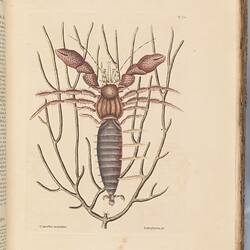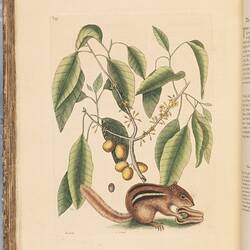Summary
Full title: 'The natural history of Carolina, Florida, and the Bahama Islands: containing the figures of birds, beasts, fishes, serpents, insects, and plants; particularly, those not hitherto described, or incorrectly figured by former author by the late Mark Catesby; revised by Mr. Edwards; to the whole is now added a Linnaean index of the animals and plants.'
Mark Catesby was an English naturalist who travelled to the North American colonies 1712-1719 and 1722-1726 to study the local flora and fauna. Trained in botany, he observed, painted and described many plant and animal species. This research formed the basis of his book 'The natural history of Carolina, Florida, and the Bahama Islands', which he published after his return to England.
To save money on publishing, Catesby wrote the text, etched the copper plates and initially hand coloured every print. To fund this operation, Catesby issued the book in parts via subscription, which was a common way to fund the printing of expensive books at the time.
As the first colour plate publication on the natural history of North America, it remained influential for a long period, and was reproduced in a number of editions. This is a third edition, printed by Benjamin White in 1771. This edition brought the study up to date with a Linnaean index. With text in both English and French, the third edition also has reset text and the appendix has been renumbered 101 to120.
The third edition is rare in Australian public collections, with one copy held by Museums Victoria, one held by the State Library of Victoria and another held by the State Library of New South Wales.
The second volume is made up of five parts, has 100 pages and a 20 page appendix at the end of the volume. This volume was divided into sections treating fish, amphibians, mammals and insects. The volume ends with a Linnaean index/appendix which depicts some animals and plants Catesby was unable to see in person.
Physical Description
Hardcover volume of 57cm with brown leather on the casing and the fore-corners of the boards. The spine has seven compartments, seven raised bands, and gold tooling. Volume two consists of the final five parts of the publication. The volume features marbled end pages, and the title page is printed in black ink. Some pages are uncut. There are a total of 220 hand-coloured etched plates across the two volumes by and after Catesby, these are mostly signed with his cipher, except for a few of the plates, such as plates 61 and 96 in volume two which have been signed by G.D. Ehret.
Significance
As the first colour plate publication on the natural history of North America, 'The natural history of Carolina, Florida, and the Bahama Islands' remained influential for a long period.
More Information
-
Collecting Areas
-
Author
Mark Catesby, London, England, 1771
Having already made a round trip to Jamacia and Bermuda in 1714, The Royal Society endorsed Catesby's venture to South Carolina in 1720. Arriving in 1722 Catesby explored South Carolina and the Bahamas until 1725. Mark Catesby released 'The natural history of Carolina, Florida, and the Bahama Islands' in parts between 1729 and 1743. The third edition was printed in 1771. -
Publisher
B. White, London, England, 1771
London: B. White listed as the publisher. -
Inscriptions
Both volumes contain a bookplate of English botanist Henry Barron Fielding.
-
Category
-
Discipline
-
Type of item
-
Dimensions
57 cm (Length)
-
References
McBurney, H. (2021) Illuminating natural history: The art and science of Mark Catesby. London: Paul Mellon Centre for Studies in British Art. The Natural History Museum and Pethers , H. (2013) NaturePlus: Library & Archives: Item of the month (June 2013) Mark Catesby 1683-1749, The Natural History Museum - Recent Posts. Available at: [Link 1] Nelson, E.C. (2015) The curious mister Catesby: A 'truly ingenious' Naturalist explores New worlds. Athens, Ga: Univ. of Georgia Press. The Smithsonian Institute (1997) Mark Catesby, Smithsonian Magazine. Available at: [Link 2]
-
Keywords
Animals, Flora, Birds, Insects, Natural History, Pictorial works, Plants











